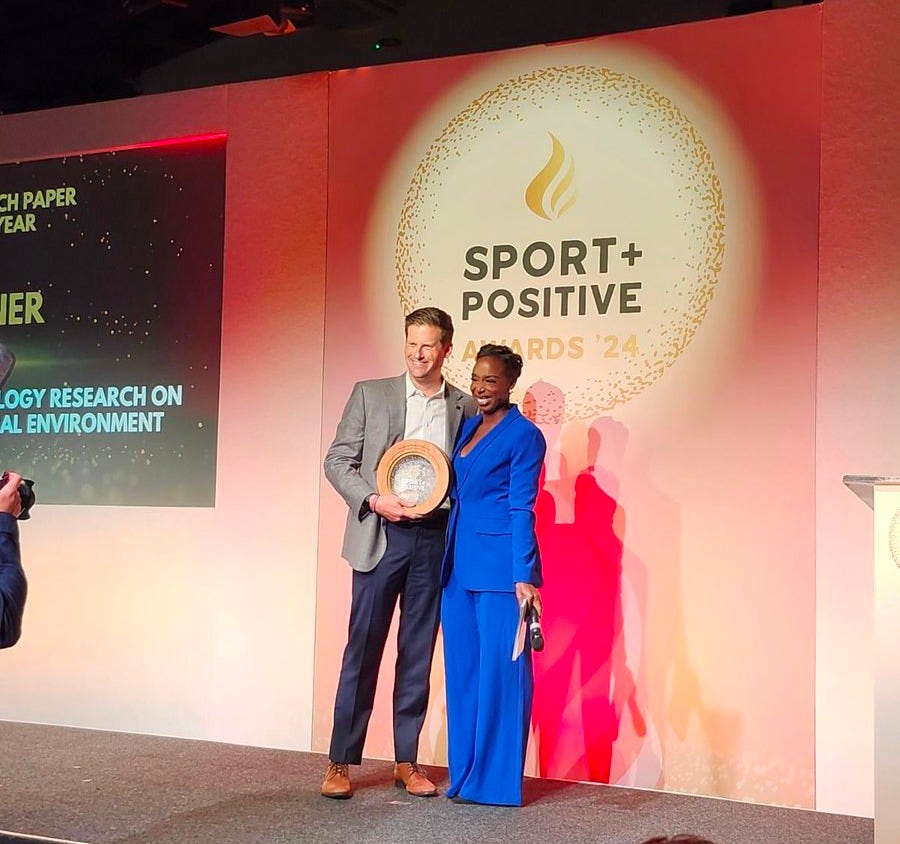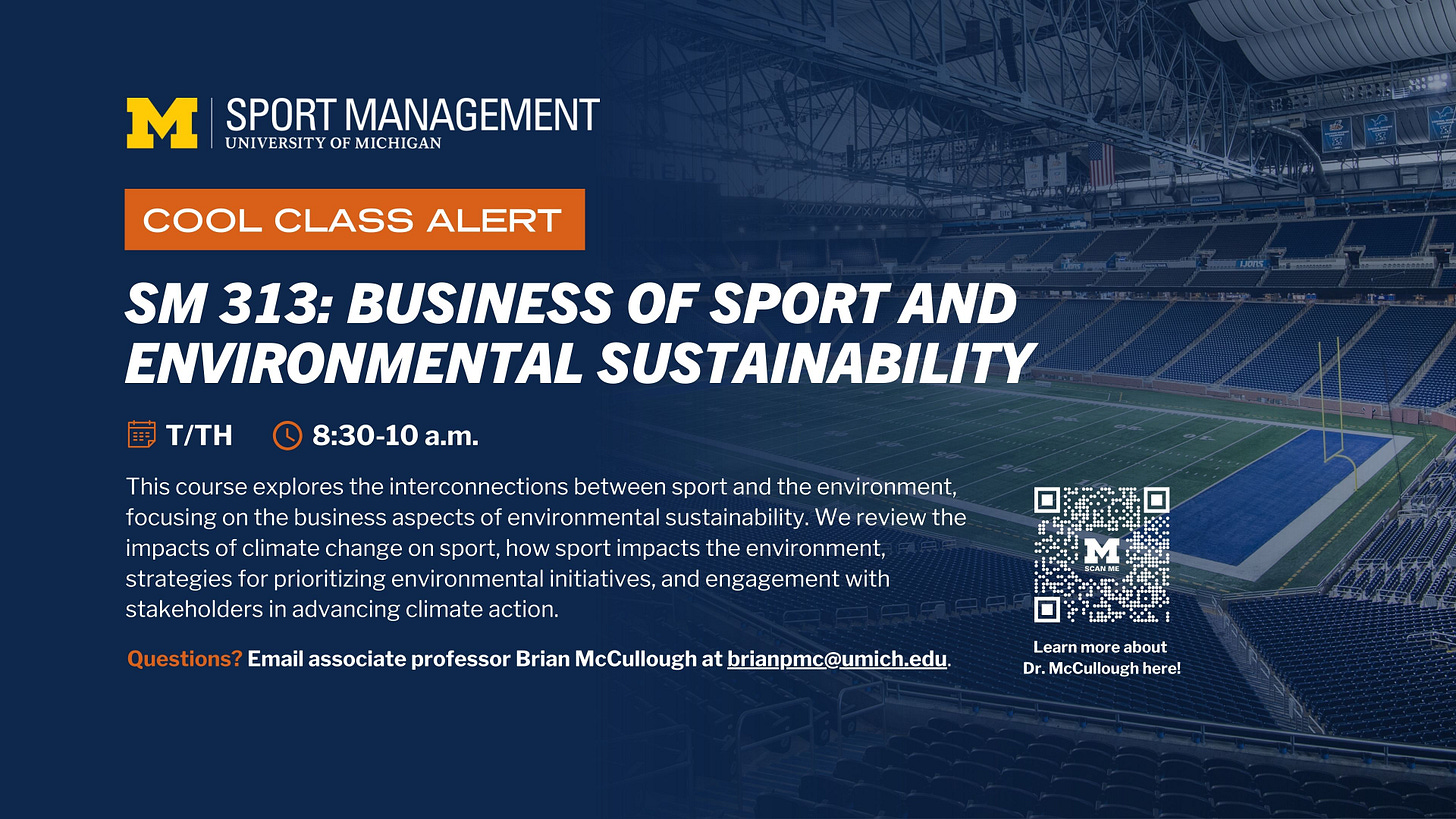Why this course merges business logic with sustainability to shape sport’s future
"Sport is disproportionately impacted by climate change than it contributes to it," Dr. Brian McCullough tells The Asterisk. He is preparing the next generation of sustainability leaders in sport.
Highlights:
Preparing future professionals: This well-established field offers a solid foundation of theory and practical examples, equipping students to take on leadership roles in the sport industry.
Empowering responsible leadership: The course provides students with the knowledge and tools to help sport organisations balance environmental responsibility with economic profitability.
Aligning sustainability with business goals: Students gain insights into integrating environmental sustainability into business objectives, proving that both can coexist and drive meaningful change.
You are quite renowned in this industry, but for those who do not know you, how would you introduce yourself?
My name is Brian McCullough. I am an associate professor and program chair of Sport Management at the University of Michigan. My research centres on sport’s environmental impacts, strategic decision-making, and stakeholder engagement. I contributed to the United Nations Sports for Climate Action framework and various initiatives to enhance environmental sustainability in sport, including the United States’ National Climate Assessment.
What sparked your interest in the intersection of sports and environmental sustainability?
Growing up, I loved the environment and learned to appreciate nature, especially during summers in Lake Tahoe, where my dad emphasised conservation. My passion for sport, particularly baseball, led me to combine these interests in my doctoral programme, where I’ve been able to contribute to this emerging area of research.
What inspired you to create this course?
In my second academic position at Seattle University, I had an opportunity to create an online certificate focused on sport sustainability leadership. After leaving Seattle University, the certificate programme concluded; I did not have the chance to teach the class focused on supporting the environment at Texas A&M University. When I was recruited to the University of Michigan, I asked if I could teach a class or a series of courses on the topic of sport business and environmental sustainability. They responded that we would want our faculty to teach within their expertise. The University of Michigan's fight song talks about the leaders and the best, and that is what we strive to do in our sport management programme more broadly. Specifically, I want to provide our students with the knowledge and understanding of how sport organisations can be environmentally responsible and economically profitable.
Why focus on ‘Business of Sport and Environmental Sustainability’ rather than ‘Sport and Environmental Sustainability’?
The focus is on the sport business, as our movement is stalled and needs to better engage decision-makers and stakeholders in implementing meaningful environmental sustainability initiatives. The class addresses organisations' challenges in this area and prepares students to effectively make the business case for sustainability while preserving profits and enhancing the fan experience.
Can you tell me more about the course?
The class spans 14 weeks and focuses on the threats organisations face from climate change and strategies for adaptation. It examines how sport contributes to climate issues and emphasises identifying unavoidable impacts while seeking opportunities for further mitigation. We debate acceptable impact levels, recognising that all human activities affect the environment. By measuring these impacts, we uncover opportunities for organisations to reduce their footprint and prioritise initiatives based on stakeholder perspectives. After implementation, we involve external stakeholders such as fans, participants, and business partners.
What is the ultimate aim of this course? Will it give students a superficial understanding or delve deeper into the subject?
The course aims to prepare students for careers in the sport industry and develop them into future leaders. We empower students to discuss how environmental sustainability can align with business objectives while protecting the natural environment. It focuses on managers' perspectives under financial pressure to achieve business goals.

What are the intended learning outcomes of the course?
Analyse the Interconnections between Sport and Environmental Sustainability:
Evaluate the complex relationships between sporting activities and environmental sustainability, recognising sport's positive and negative environmental impacts and vice versa. (Analysing)
Understand and articulate key concepts and frameworks related to environmental sustainability within the context of the sport industry. (Understanding)
Assess the Impacts of Climate Change on Sport:
Critically analyse the vulnerabilities of different sports to climate change, considering geographical and seasonal variations. (Analysing)
Evaluate adaptive measures and strategies employed by sport organisations to mitigate the effects of climate change on their activities. (Evaluating)
Implement and Manage Sustainability Initiatives:
Develop strategic plans for implementing sustainability initiatives in sport organisations, emphasising the importance of resource efficiency, sustainable certifications, and compliance with environmental policies. (Creating)
Apply best practices and innovative solutions to real-world scenarios to reduce the environmental footprint of sport events and facilities. (Applying)
Engage with Stakeholders to Advance Climate Action:
Identify and analyse the roles of various stakeholders in promoting environmental sustainability in sport, including athletes, fans, sponsors, and community members. (Analysing)
Design and execute effective stakeholder engagement strategies to foster collaboration and promote climate action within the sport industry. (Creating, Applying)
Measure and Report on Sustainability Performance:
Develop and use appropriate metrics and indicators to measure the sustainability performance of sport organisations and events. (Creating, Applying)
Evaluate existing sustainability reports to understand the importance of transparency, accountability, and continuous improvement in environmental initiatives. (Evaluating)
Synthesise Knowledge to Address Future Trends and Challenges:
Reflect on the cumulative knowledge gained from the course to predict future trends and identify emerging challenges in sport and environmental sustainability. (Synthesising)
Propose innovative solutions and strategies to address these challenges, ensuring the sport industry can adapt and thrive in an increasingly sustainability-focused world. (Creating)
How important is maintaining objectivity in such a course, and what are the pitfalls of taking an ideologically driven approach?
It's important to remain objective and consider different perspectives, as effective leaders must understand opposing views and negotiate conflicting opinions to achieve common goals. In this course, we focus not on debating climate change's existence but on recognising its impact on support organisations and the sport industry, which may face significant challenges moving forward. We also note that sport is disproportionately impacted by climate change than it contributes to it. Therefore, we analyse this issue through business logic, exploring competing environmental perspectives to find solutions that allow organisations to reduce their environmental impact while improving economic efficiencies.
Will there be any notable guest speakers or industry experts featured in the course?
We have a great lineup of guest speakers planned for the class. I encourage everyone to check social media for updates from the School of Kinesiology at the University of Michigan and my channels. In particular, we'll feature University of Michigan alums who are thought leaders in the field, showcasing our best network in sport.
Rosenberg notes that the term ‘sustainability’ has been used for decades but remains imprecisely defined. How do you define sustainability?
Sustainability means preserving environmental, social, and economic resources for future generations1. While this class emphasises environmental sustainability, it's essential to recognise the interplay with social and economic factors, which will also be discussed.
Similarly, ‘sport-environmental sustainability’ (sport-ES) lacks a universal definition. Can you expand on this challenge?
Sport environmental sustainability, or sport ecology, explores the mutual relationship between sport and the natural environment. Our sporting activities affect the environment, and in turn, the environment influences our ability to engage in sport and recreation. Ensuring environmental sustainability is vital for maintaining the quality of sport and recreational opportunities for future generations across social, environmental, and economic dimensions.
This subject is still in its nascent stages. What are the challenges of teaching this module, especially given the weight of its implications?
This well-established field can support a course to prepare students for professional roles. It offers both theoretical material and practical examples to build a solid foundation and encourage ambitious goals in promoting environmental sustainability within the sport sector. We aim to equip this understanding to the future leaders of the sport industry.

Were there any specific barriers you faced in designing and organising the course?
I have taught similar courses, and Seattle University's version has been enhanced to reflect current trends in the sport sector, focusing on environmental sustainability. This improvement is based on the work of dedicated academics and practitioners in the field.
Was there anything that struck you most during this process?
Developing this class was a straightforward process. It makes sense to take a business approach to engage our students in integrating and implementing environmental sustainability within those processes. By embracing business logic, we can better understand how to navigate the system and connect with stakeholders from their perspective. This process was significantly improved by input from practitioners, ensuring that our students acquire the skills needed for entry-level positions in sustainability.
Asian business schools reportedly face barriers such as skepticism about accepting sustainability education. Does this make the West a more ideal place for such education?
I cannot comment on the challenges mentioned in Asia, but teaching this class at the University of Michigan has been an incredible experience. The support and enthusiasm for this initial course offering are outstanding. In the future, this course will be offered every semester, and the curriculum will expand to include additional subjects focused on environmental sustainability.
MacVaugh & Norton (2012) stated that sustainability education is ‘inherently problematic.’ One issue is the uncertainty about where sports want to head with such education. Why is this the case? Does the business aspect of sports influence this ambiguity?
I am unfamiliar with the context these authors2 refer to regarding the problems of environmental sustainability education. Cheryl Mallen suggests that sustainability is dubious because it involves the ongoing pursuit of environmental, social, or economic improvement. With its drive for constant improvement and better performance, sport provides an excellent context for teaching this material.
They also suggest that educators, being part of the generation responsible for global environmental damage, might not be the best to teach the next generation about safeguarding the environment. How do you respond to this critique?
Students respond well to challenges in the classroom. They are ready to tackle important issues like climate change and environmental sustainability. Instead of blaming previous generations for their environmental damage, we should work together across different industries to achieve our common goals and address today’s challenges. We must operate with the best knowledge and information and advance this movement to buffer and refine our understanding.

Some students feel that the time allotted to grasp complex subjects is often insufficient. Do you believe the students pursuing this programme will have sufficient time to understand the subject comprehensively?
This course provides an overview of how sport organisations can enhance environmental sustainability while meeting financial objectives and improving customer experience. It encourages students to consider what is possible and achievable for organisations regarding sustainability now and in the future.
What would you advise students to do to maximise their time in this programme?
On the first day, I advised my students to identify opportunities for conversations and recognise the obstacles that might prevent organisations from joining. They should then learn how to effectively address these concerns to promote and foster positive change within those organisations.
What excites you most about the future of sport and environmental sustainability?
I am excited to see more support organisations know the value of protecting the natural environment related to their objectives. As we develop a deeper understanding and advance our research, we can demonstrate an organisation's environmental, social, and economic value to be committed to deeply integrating environmental sustainability throughout their organisation's operations and governance.
Follow Dr. McCullough and Michigan Kinesiology for more updates on the business of sport and the environment.
Dr. McCullough’s award-winning paper ‘Advancing sport ecology research on sport and the natural environment’ can be accessed here.


